10 Andaman Sea Facts You Might Not Know
The Andaman Sea is known for its breathtaking beauty and awe-inspiring views. Its turquoise and crystal clear waters make it perfect for snorkelling or diving, while its white sandy beaches lined with palms are enough to calm a troubled heart.
Nature lovers flock to the Andaman Sea to enjoy the beautiful sunsets that paint the skies in mesmerising hues of orange, pink and purple. It is also famous for island hopping as there are many islands in the Sea, each offering a unique experience.
In this article, let us dive into some fascinating facts about the Andaman Sea that might compel you to plan a trip to the Andaman Sea quite soon!
1. Andaman Sea was created in the Late Cretaceous Period
The Andaman Sea is approximately 750 miles or 1200 km long and is 647 km wide. It covers a surface area of 797,000 square kilometres and has an average depth of 1096 metres. Due to underwater valleys, its depth exceeds in some places. The maximum depth of the sea is around 4,198 m.
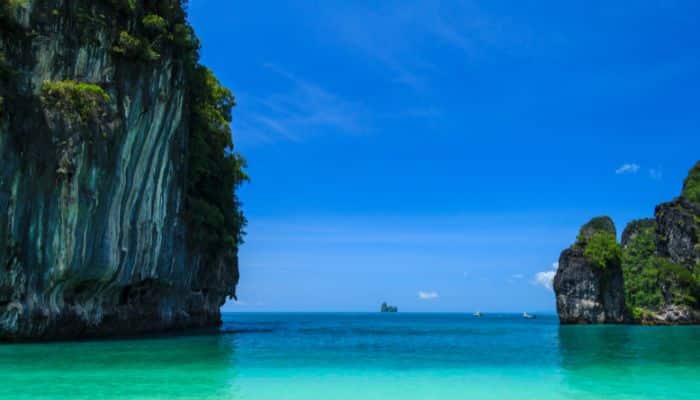
Also called the Burma Sea, the Andaman Sea is a marginal water body of the northeastern Indian Ocean. It is surrounded by Myanmar and Thailand’s coastline, running along the Martaban Gulf and the western part of the Malay Peninsula. Towards its western side, it is distinguished from the Bay of Bengal by the Andaman and Nicobar Islands. The southern end lies near the island of Breueh.
It is said that the Andaman Sea was formed due to the tectonic activities that happened during the Late Cretaceous Period, from about 100 to 66 million years ago.
In this period, the Indian Plate started to move northward gradually and then struck the Eurasian Plate, which led to the birth of the Himalayas and the uplift of the Tibetan Plateau. The shifting of the Indian Plate opened the Andaman Sea and separated the Andaman and Nicobar Islands from the mainland.
However, it is important to know that the Andaman Sea is still geologically evolving and changing due to tectonic activities and many other topographic factors.
2. The Andaman Island in the Andaman Sea is home to South Asia’s only active volcano
True to its name, Barren Island is a desolate and uninhabited place in the Andaman Sea. It is 138 km from the territory’s capital city Port Blair. It is not only India’s but Asia’s only active volcano that has erupted quite frequently over the years and caused significant damage.
The first eruption was in 1787, and many others followed, the most recent being in 2020. However, since then, it spews less lava than earlier. It is three km wide and has a 1.6 km broad crate with a cinder cone that has been the eruption source.
It is a protected region which comes under the purview of the Barren Island Wildlife Sanctuary.
No humans live on this island, although researchers were first surprised to find a small group of feral goats. They survived due to the presence of two freshwater sources and lush vegetation. British sailors had brought the goats in the late 18th century. Birds such as pigeons, flying foxes, and rodents like rats also live on the island.
3. Large-scale commercial fishing is banned in the Andaman Sea
The Andaman Sea has several marine species that are commercially valued. However, uncontrolled and unsustainable fishing practices have threatened the lives and livelihoods of communities and the fragile ecosystem’s sustainability.
It has led to the reduction of fish populations in the past. Hence, to protect the Andaman Sea’s flora and fauna, commercial fishing on a large scale was banned in the Andaman Sea.
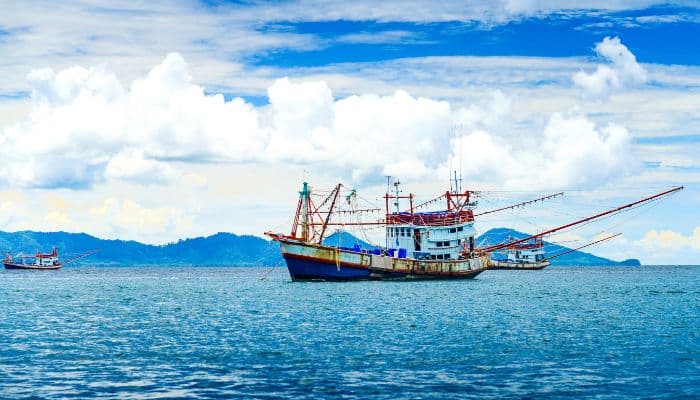
The administrations of India, Thailand and Myanmar have put several regulations and management steps in place for checking the same. For instance, there are strict restrictions on using particular types of fishing gear; there is a practice of seasonal closing for some species and a cap on the quantity of fish that can be caught in some areas of the sea. Some regions are categorised as marine protected zones where fishing is prohibited.
All in all, these steps ensure that the marine resources of the Andaman Sea are not misused.
4. One of the largest crabs in the world lives in the Andamans
The biggest land anthropods, the hermit crabs, are residents of the Andaman Islands. Also called the coconut crabs, palm thieves or robber crabs, the Andaman Islands are home to the most number of these mighty creatures.
They can weigh up to four kilograms and have a three-foot leg span. They live in burrows and eat fleshy fruits, nuts, seeds, the pith of fallen trees, and practically any organic matter that falls on the ground. They may also take it away to their homes, which gives them the name robber crabs.
These crabs are found throughout the islands of the Indian Ocean and parts of the Pacific Ocean, such as Pitcairn, Gambier and Caroline Islands. In Africa, they live close to Zanzibar off Africa’s coast.
Apart from these crabs, the Andaman Sea is home to Dugongs or sea cows, the Irrawaddy dolphin, and endangered turtles like the leatherback turtle, hawksbill turtle, green turtle and olive ridley turtle.
5. Home to many awe-inspiring coral reefs
The Andaman Sea has many coral reefs. Located in the eastern part of the Indian Ocean, it borders Thailand, Indonesia, Myanmar and India. Its warm waters are ideal for supporting an array of coral species and species of fish, sponges, anemones, starfish etc.
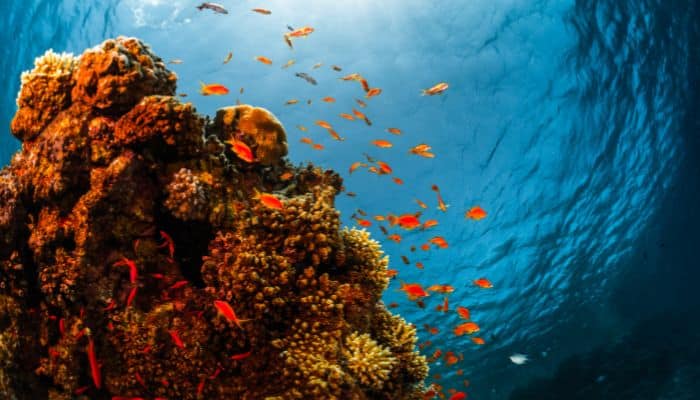
Some famous coral reefs are the Similan Islands in Thailand, known for their transparent and clean waters and vibrant coral formations. The Surin Islands are a treat for divers and snorkelers as they can encounter whale sharks and even manta rays.
The Mergui Archipelago comprises more than 800 islands, many of which have pristine corals untouched by tourists. Magnificent creatures like reef sharks dwell here.
6. North Sentinel Island is home to the isolated Sentinelese People
North Sentinel Island is home to one of the most secluded and secretive tribes in the world. The Sentinelese people have cut themselves off from the modern world and have lived on the island for 60,000 years.
The island is a part of India’s Andaman and Nicobar Islands and has been declared off-limits for the people to preserve the culture and lifestyle of the Sentinelese people.
This step also ensures the safety of outsiders, as Sentinelese people are pretty suspicious, unwelcoming, hostile and aggressive towards anyone who tries to come to the island.
They are said to number around 300 and fire arrows at anybody who tries to approach them. It is assumed that the tribe descended directly from the first human population that emerged in Africa.
Today, very little is known about their ways of life, culture and language, making them one of the most isolated and mysterious groups of people on our planet.
7. Andaman Sea has a tropical climate
The Andaman Sea experiences high temperatures and high humidity levels throughout the year. Its location in the northeastern Indian Ocean affects its climate and rainfall patterns.
It has two main seasons: the southwest monsoon, which lasts from May and ends in October, while the northeastern Monsoon begins in November and ends in April. During the former, the sea has heavy rains and strong winds, including high tides. During the latter, the sea experiences less rainfall and gentle winds.
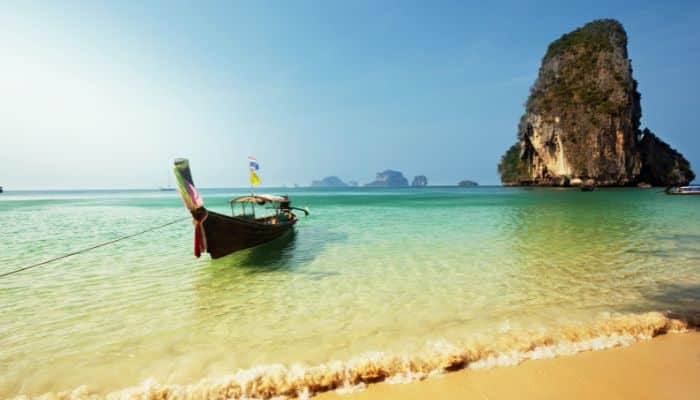
Hence, the sea remains warm all year round, with temperatures ranging from 27 to 30 degrees Celsius. Occasional storms and tropical cyclones occur during monsoons, bringing strong winds and heavy rainfall to coastal areas.
8. Andaman Sea is one of the world’s most famous diving spots
Diving in the clear waters of the Andaman Sea, brimming with diverse marine organisms and colourful coral reefs, is a once-in-a-lifetime experience for novice and experienced divers.
There are many famous diving spots, such as Richelieu Rock which lies in the Surin Islands. It is one of the best diving spots where one can expect to encounter whale sharks, manta rays, sea anemones and barracudas.
Similan Islands in the Andaman Sea has dive sites like Elephant Head Rock, Shark Fin Reef and East of Eden. They are known for reef sharks and sea turtles. Other famous dive sites in the Andaman Sea include Koh Tachai, Koh Bon, Hin Daeng and Hin Muang. The latter two are known for their deep walls and large schools of fish.
Diving at some spots is a little challenging due to strong currents. Hence, one can hire a guide or instructor from the many diving operators and even learn some of the basics before diving into the waters of the Andaman Sea.
9. Andaman Sea has five important ports
Phuket Port of Thailand is a famous tourist destination that handles cruise ships, yachts and other marine ships. Cargoes such as construction materials, fuel, and industrial goods are also dealt with. Secondly, it handles fishery products, including fresh fish, crabs and shrimp.
Myanmar’s Yangon Port is the biggest in the country and connects it with the world. It has many terminals, such as the Asia World Port Terminals and Myanmar International Terminal, Thilawa. They have container handling facilities and can handle containerised cargo, liquids, and dry bulk cargo.
Chennai Port in India is one of the oldest facilities in the country, which deals with finished goods, consumer products, raw materials, petroleum goods, chemicals and edible oils, coal, fertilisers, iron ores and project cargo such as heavy machinery, equipment and automobiles.
Belawan Port in northern Sumatra, Indonesia, is the busiest port in Sumatra and the second-busiest in the country, after Tanjung Priok in Jakarta. It serves as a trade gateway between Sumatra and other regions of Indonesia. It also connects the country with countries in Asia, the Americas and Europe.
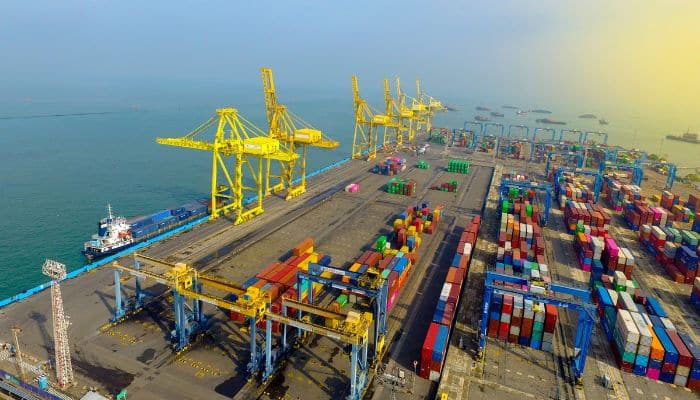
Image for representation purposes only
It has several terminals; the main cargo is containers, liquid and dry bulk. It is equipped with modern infrastructure to boost trade and commerce. Its development and refurbishment were important for the economic growth of Indonesia.
Lastly, the Port Blair Port lies in the Andaman and Nicobar Islands and is the main hub for trade and tourism. It is located in the islands’ capital city and serves as a connecting point between the islands and mainland India and other countries.
It has three terminals, including the passenger terminal, which caters to cruise passengers. The cargo terminal handles petroleum, food grains and construction materials. It also has a naval base which the Indian Navy uses. A container terminal was also constructed, which increased its cargo handling capacity.
10. The Andaman Sea has served as an important trade route since ancient times
Trading ships have crossed the Andaman Sea since the ancient ages. The Andaman Sea was a crucial part of the trade route between India and Ceylon or Sri Lanka and the Burmese ports of Thaton, Tavoy and Martaban.
Per the research, the sea has been used for trading purposes since the time of the Harrapan Civilization in the Indus Valley and Southeast Asia’s Srivijaya Empire. In medieval times, it was visited by Arab and Chinese merchants and traders who brought exquisite silk, spices and other commodities from Southeast Asia to the Middle Eastern Region.
Presently, the sea is used for trade and largely tourism. It is also strategically crucial, with several countries having naval bases in the sea. Also, many military exercises are conducted here.
You Might Also Like To Read-
- 10 Denmark Strait Facts You Might Not Know
- 10 Gulf Of Alaska Facts You Might Not Know
- 10 Baffin Bay Facts You Should Not Miss Out
- 10 Buildings In The World Inspired By The Sails Of A Ship
- 10 Longest Ships In The World
Disclaimer :
The information contained in this website is for general information purposes only. While we endeavour to keep the information up to date and correct, we make no representations or warranties of any kind, express or implied, about the completeness, accuracy, reliability, suitability or availability with respect to the website or the information, products, services, or related graphics contained on the website for any purpose. Any reliance you place on such information is therefore strictly at your own risk.
In no event will we be liable for any loss or damage including without limitation, indirect or consequential loss or damage, or any loss or damage whatsoever arising from loss of data or profits arising out of, or in connection with, the use of this website.
Do you have info to share with us ? Suggest a correction
Disclaimer :
The information contained in this website is for general information purposes only. While we endeavour to keep the information up to date and correct, we make no representations or warranties of any kind, express or implied, about the completeness, accuracy, reliability, suitability or availability with respect to the website or the information, products, services, or related graphics contained on the website for any purpose. Any reliance you place on such information is therefore strictly at your own risk.
In no event will we be liable for any loss or damage including without limitation, indirect or consequential loss or damage, or any loss or damage whatsoever arising from loss of data or profits arising out of, or in connection with, the use of this website.

About Author
Zahra is an alumna of Miranda House, University of Delhi. She is an avid writer, possessing immaculate research and editing skills. Author of several academic papers, she has also worked as a freelance writer, producing many technical, creative and marketing pieces. A true aesthete at heart, she loves books a little more than anything else.
Latest Maritime Knowledge Articles You Would Like:
Subscribe To Our Newsletters
By subscribing, you agree to our Privacy Policy and may receive occasional deal communications; you can unsubscribe anytime.















